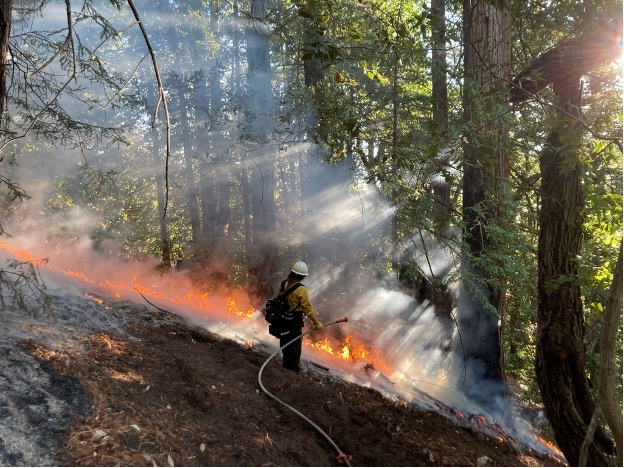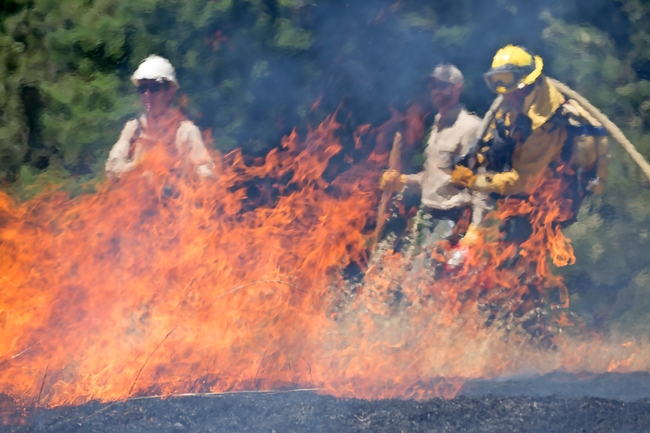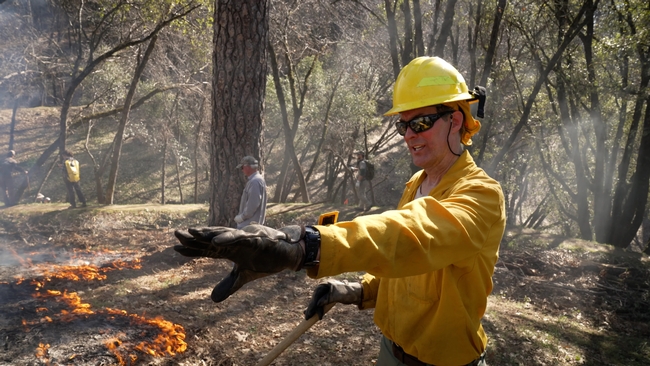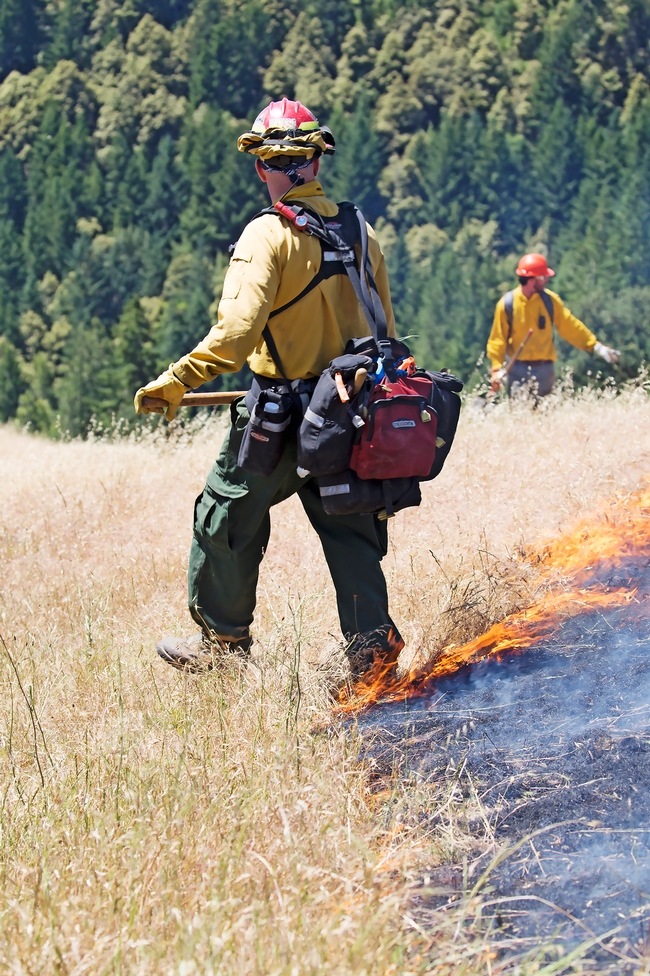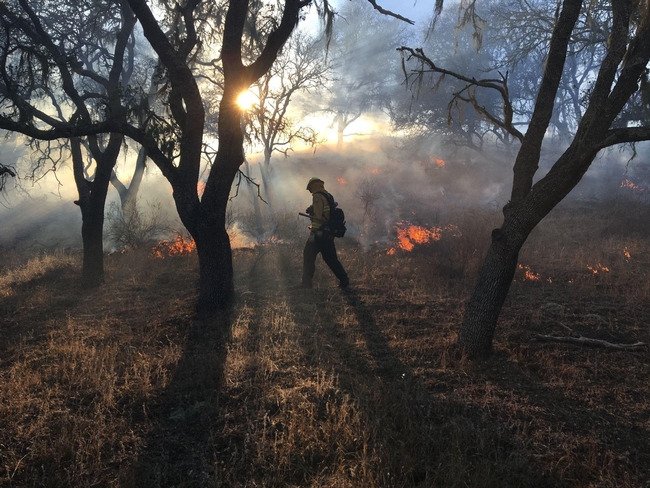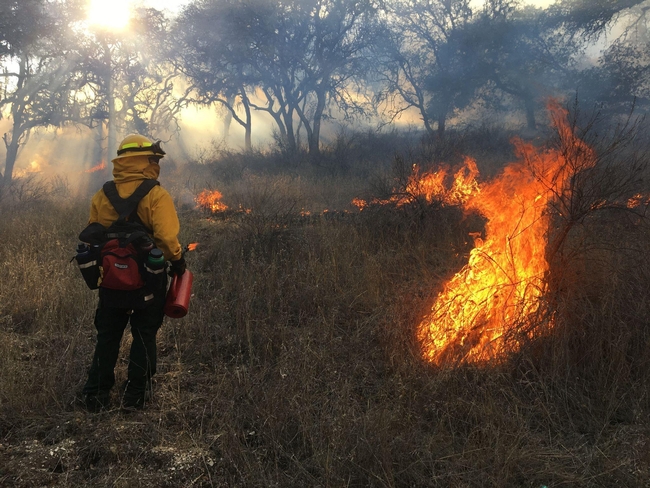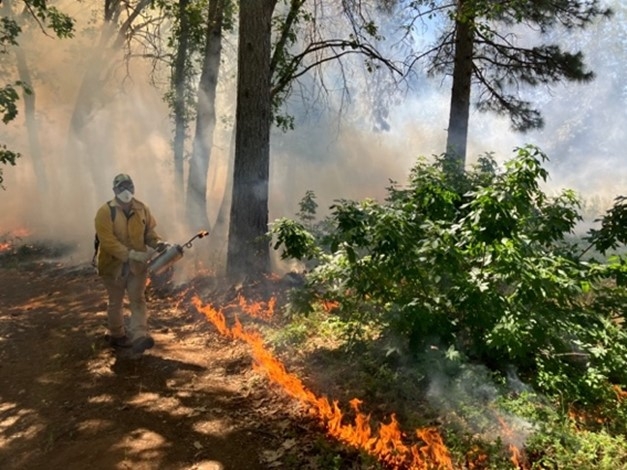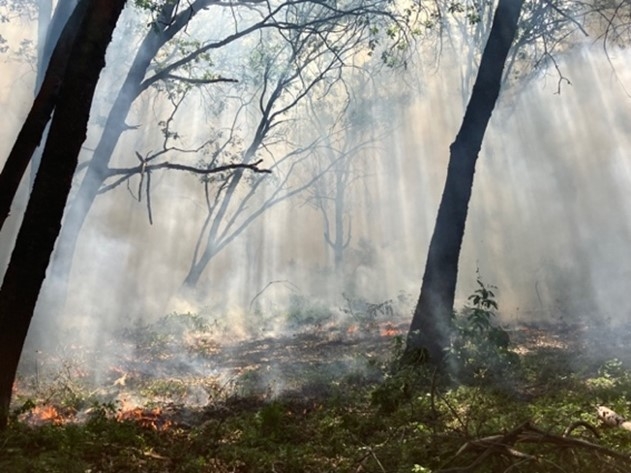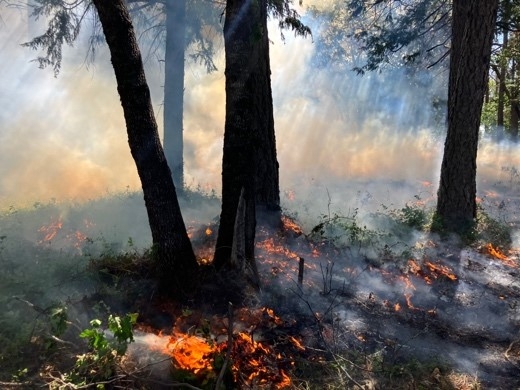
Posts Tagged: burn
Public invited to observe prescribed fire training in Santa Cruz County
First Forester TREX to be held June 3-6
California's first-ever Forester Prescribed Fire Training Exchange event focused on bringing together professional foresters, forest managers and fire practitioners will occur June 3-6 near Watsonville. The four-day event is being hosted by the Central Coast Prescribed Burn Association, which empowers the public to build a culture of good fire and supports private landowners in conducting prescribed burns in Monterey, San Benito and Santa Cruz counties.
There will be one burn conducted during the event, likely on June 4 or 5, which will be open for the public to observe.
Prescribed Fire Training Exchanges (TREXs) first came to Northern California in 2013, and have made a positive cultural shift concerning prescribed fire, within both regional fire services and the general public. These “good fire” TREX events have drawn significant attention, especially in the context of more severe wildfire seasons.
After months of cross-organizational planning, the four-day long training will be focused on exploring the connections between sustainable forest management, wildfire resilience, timber harvesting, prescribed fire, and will include a burn within a commercially harvested redwood forest. The TREX will provide experiential training opportunities to forest managers and planners to advance statewide knowledge of how to conduct prescribed fire in merchantable timber stands.
Along with the prescribed burn, the program will include lectures, local tours, and open discussions on how to incorporate fire into timber management, burn planning and timber harvest planning, pre- and post-fire considerations, and permitting mechanisms for fire and timber harvesting. Presentations will be given by local forestry consultants, University of California Agriculture and Natural Resources, CALFIRE and local fire practitioners.
The burn location will occur near Mount Madonna, on private land with access allowed for accompanied observation only. Be advised, while the ForesterTREX planning team works closely with theMonterey Bay Air Resources District to assure good smoke dispersal, smoke may be seen and be present in these areas during and after a burn. Please see the Central Coast Prescribed Burn Association webpage at calpba.org/centralcoastpba for updates close to the burn date.
Participants and partners include the Mount Madonna Center, members of the Amah Mutsun Tribal Band and the Esselen Tribe of Monterey County, University of California Agriculture and Natural Resources, Resource Conservation District of Monterey County, CALFIRE, local land trusts, scientists, ranchers, students, researchers, land managers and others. The Central Coast Prescribed Burn Association is currently funded via California Coastal Conservancy grants.
For more information or to join a group of observers, contact Barb Satink Wolfson, UC Cooperative Extension area fire advisor at bsatink@ucanr.edu.
Reforms needed to expand prescribed burns
Study highlights 4 strategies to overcome barriers to prescribed fire in the West
Prescribed fire, which mimics natural fire regimes, can help improve forest health and reduce the likelihood of catastrophic wildfire. But this management tool is underused in the fire-prone U.S. West and Baja California, Mexico, due to several barriers.
A paper from the University of California, Davis, pinpoints those obstacles and suggests four key strategies that policymakers and land managers can take to get more “good fire” on the ground in North America's fire-adapted ecosystems. The paper also provides examples of how people are surmounting some of these obstacles.
“Prescribed fire is one of the most important tools we have for restoring natural fire regimes and undoing the effects of a century of fire suppression,” said lead author John Williams, a project scientist with the UC Davis Department of Environmental Science and Policy. “But there are a number top-down barriers at the upper levels of management that keep us from growing the workforce and getting burns done at the scale and extent needed. We point out some of the big ways that agency leaders and policymakers can dismantle those barriers and empower the full range of people capable of doing this work, from burn bosses and citizen-prescribed burn associations to nonprofits and tribal groups.”
The paper, published in the journal Frontiers in Ecology and the Environment, centers on the North American Mediterranean climate zone, which includes most of California, southwestern Oregon, western Nevada and northern Baja California in Mexico. Lenya Quinn-Davidson, director of UC Agriculture and Natural Resources' Fire Network, is a co-author of the paper.
A natural process
Fire is a natural process that has helped shape this region, but the area has experienced a spike in destructive, high-severity wildfires over the past decade. In fact, three of the five largest wildfires in continental U.S. history occurred in this region in just the past five years. This is due to a combination of climate change and fuel accumulation driven by a century of policies that encouraged fire suppression, curtailed Indigenous cultural burning, and favored harvest of the largest, most fire-tolerant trees, the study notes.
While scientists and resource managers recognize the need for more prescribed fire, its application has not kept pace with the enormity of the challenge. The study said that is because management policies prioritize fire suppression over prevention. There is also a limited fire workforce; regulatory hurdles like permitting, insurance and liability; and few incentives or protections for landowners, tribal members and other people who burn responsibly.
4 key strategies
Researchers identified four key areas where supportive institutional and agency leadership can help expand prescribed fire in the region:
1) Fire culture. After decades of emphasizing wildfire suppression, current fire management culture “does not adequately promote prescribed fire as a management tool,” the study said. Support for prescribed fire along the entire chain of command within agencies is needed to foster a new culture that incentivizes and enables prescribed fire practitioners within and outside of government agencies.
2) Funding. Prescribed fire is considerably more cost-effective than wildfire suppression, which can cost more than $2 billion a year in the U.S., but there is little dedicated funding for prescribed fire projects and lack of flexibility as to when such money can be spent. This impedes fire staffing and limits the kinds of projects that can be done. Year-round, dedicated funding and resources could help increase prescribed fire capacity.
3) Capacity building and cooperation. Connecting agencies with landowners, community members, tribes, prescribed burning associations (PBAs), prescribed fire training exchanges (TREXs) and others can facilitate responsible, effective prescribed fire and cultural burning exchanges. Such groups have limited reach and require investment and support to meet demand.
Inter-organizational agreements can also help local, state and federal agencies share resources and staffing. Formalizing and fully integrating such agreements into fire management plans remains a challenge, the study said. Collaborations that support Indigenous cultural burning are also key.
Partnerships must recognize the unique dimensions of cultural burning, which are inseparable from Indigenous culture. Educating land managers and decision makers about tribal sovereignty and federal American Indian law is critical. Introducing legislation that supports cultural burning can also foster such collaborations.
4) Monitoring and adaptive management. Designated funding and personnel for quantitative monitoring after a prescribed burn can help practitioners better measure success and then apply lessons to future burns.
“All of the barriers identified in the study can be overcome, and they have been at least partially resolved in other parts of the U.S., as well as in other Mediterranean climate regions, such as southwestern Australia,” said co-author Hugh Safford, a research ecologist in the UC Davis Department of Environmental Science and Policy and director of the California Prescribed Fire Monitoring Program. “Fundamental to setting the situation right is developing a culture of safe and regular fire use in California and neighboring states by all landowners and managers, and reducing the officiousness, risk aversion and bureaucracy that hinders access to the tool by the public.”
Additional co-authors include Ashley Grupenhoff and Beth Rose Middleton of UC Davis; Joe Restaino of CAL FIRE; Edward Smith of The Nature Conservancy; Chris Adlam of Oregon State University; and Hiram Rivera-Huerta of Autonomous University of Baja California, Mexico.
This research received financial support from the California Department of Forestry and Fire Protection (CAL FIRE).
This story was originally published on the UC Davis News site.
Public invited to observe prescribed fire training June 4-9
The Monterey Bay area will host part of the first California Central Coast Prescribed Fire Training Exchange, or Cal-TREX.
Fire practitioners from across the state, greater North America and international locations (Spain, Honduras, Costa Rica, Ecuador) are gathering for a Prescribed Fire Training Exchange on June 3-10.
The training is hosted by the Central Coast Prescribed Burn Association, which empowers the public to build a culture of “good fire” and helps private landowners conduct prescribed burns in Monterey, San Benito and Santa Cruz counties.
Prescribed burns will be open for the public to observe on various days throughout the training, most likely June 4-9, depending on the weather. Please see the CCPBA webpage for updates on upcoming burns: http://calpba.org/centralcoastpba.
Prescribed Fire Training Exchanges (TREX) first came to Northern California in 2013, and have made a dynamic, positive cultural shift concerning prescribed fire, within both regional fire services and the general public. These “good fire” TREX events have drawn significant attention, especially in the context of more severe wildfire seasons.
After months of cross-organizational cooperative planning, participants in the weeklong training will be burning a mix of grassland, oak woodland and shrub vegetation types, and make a lasting, positive change concerning “good fire” on the Central Coast.
The TREX will provide experiential training opportunities to advance regional prescribed fire capacity, while also enhancing research to better understand the ecological response of wild plant and animal species following fire.
At this TREX event, participants will learn how to safely conduct prescribed burns in various vegetation types across three counties. Along with multiple prescribed burns, the weeklong program will include lectures and seminars on local fire ecology of plant and animal species, tribal burning practices and burn planning led by multiple burn bosses and other experts.
Burn locations may include the Nyland property (owned by Trust for Public Land and San Benito Agricultural Land Trust) near San Juan Bautista, the Santa Lucia Conservancy near Carmel Valley and the Kechun Village (owned by the Nason family) in Arroyo Seco.
Be advised, while the CCTREX works closely with the Monterey Bay Air Resources District (MBARD) to assure good smoke dispersal, smoke may be seen and present in these areas during and after a burn. Please see the CCPBA webpage for updates on upcoming burns: http://calpba.org/centralcoastpba.
BurnBot, a new technology featuring a mobile burn chamber, remote-controlled mastication and fire drone systems, will be used for the prescribed burn on June 4. To observe the Nyland burn on June 4, register at https://bit.ly/CCPBApublicRxfire. Details including time and directions will be emailed to registered participants.
Participants and partners include members of the Amah Mutsun Tribal Band and the Esselen Tribe of Monterey County, University of California Agriculture and Natural Resources, Resource Conservation District of Monterey County, CAL FIRE, local land trusts, scientists, ranchers, students, researchers, land managers and others. The CCPBA is funded by two CAL FIRE wildfire prevention grants.
For more information, contact Jamie Tuitele-Lewis, fire fuel mitigation program and forest health coordinator, at jtlewis@rcdmonterey.org or Barb Satink Wolfson, UC Cooperative Extension area fire advisor, at bsatinkwolfson@ucanr.edu.
Coyote Brush Control Study Proposal
UC Cooperative Extension San Benito County is going to collaborate with San Jose State University to develop a CAL FIRE Forest Health Research grant proposal. We are interested in looking at different methods to control coyote brush (Baccharis pilularis). Coyote brush is a native shrub. However, it...
New El Dorado/Amador Prescribed Burn Association conducts first private landowner burns
The new El Dorado/Amador Prescribed Burn association, formed in August 2021, has conducted several burns with private landowners and received funding for a part-time coordinator.
A new group of local residents dedicated to helping private landowners conduct prescribed burns on their own properties has formed in El Dorado and Amador Counties. The group was convened by Susie Kocher, forestry advisor for the University of California Cooperative Extension in the Central Sierra.
“Prescribed Burn Associations, or PBAs, are groups of landowners helping each other to both learn how to use prescribed fire to manage their properties and to help each other carry it out. They have been common in other states in the Midwest and Southeast United States, but are relatively new to California,” said Kocher. The first PBA was formed in Humboldt County and now there are at least 20 in various stages of development throughout the state.
New El Dorado/Amador PBA holds first burns
To date, the local group has held workshops on prescribed burn use, planning and integration with targeted grazing for fuels reduction. The group held their first broadcast burn on May 15, 2022, at LBS Ranch in Placerville. Due to rain in April, the group was able to take advantage of the tail end of the spring burning window. The event served as an educational opportunity for members to get more live fire experience and discuss the planning and implementation process.
Those who attended were landowners, volunteer fire department members, foresters and community members with varying degrees of experience. Together they reduced fuels and resprouting shrubs by burning an acre of forested land that had previously been thinned and masticated. Fire behavior and effects occurred as planned, with low flame lengths and good consumption of live and dead vegetation.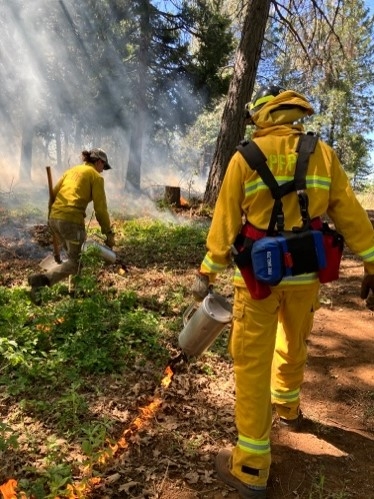
Funding received for part-time coordinator
In April, the University of California Cooperative Extension was awarded funding through a Regional Forest and Fire Capacity subaward from the Watershed Research and Training Center, by a grant awarded by the California Department of Conservation to hire a part-time PBA coordinator. A total of nine PBAs across the state received subawards to fund leadership, peer mentorship, training and travel. The El Dorado/Amador PBA was awarded funding for a half-time coordinator for the next two years. The new coordinator, Kestrel Grevatt, is based at UC Berkeley's Blodgett Forest Research Station and will be splitting her time between the PBA and her role as intern forester at Blodgett. She has a background in fire suppression, prescribed burning and implementing and overseeing fuels reduction work.
Looking forward, the group is planning a burn plan writing workshop for August. This workshop will be intended to help landowners understand the prescribed fire planning process, necessary burn plan components and help them walk away at the end of the day with a drafted burn plan. Attendees will have the opportunity to download and create maps, plan burn units, discuss permits needed and smoke considerations, and write a weather/fuels prescription, all with guidance from PBA leaders and agency representatives. Through the fall and winter, the group's priorities will be to implement burns and make local and regional training opportunities available to members.
“The overall goal of the group is to give community members the support to safely and effectively put good fire on the ground. By starting small, with a few acres at a time, members can learn how to use this tool and develop comfort with fire as a process. Over time, with many landowners' involvement, we can continue to increase the pace and scale of prescribed fire,” said Grevatt.
For more information, please contact Kestrel Grevatt kestrelgrevatt@berkeley.edu.
The work upon which this publication is based was funded in whole or in part through a Regional Forest and Fire Capacity subaward from the Watershed Research and Training Center, by a grant awarded by the California Department of Conservation. The El Dorado / Amador PBA is also supported by UC ANR.

